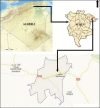An ethnobotanical survey of galactogenic plants of the Berhoum District (M'sila, Algeria)
- PMID: 28894630
- PMCID: PMC5580957
- DOI: 10.5455/jice.20170811073514
An ethnobotanical survey of galactogenic plants of the Berhoum District (M'sila, Algeria)
Abstract
Background/aim: This work aimed an ethnobatanical study on the galactogenic plants used in the Berhoum region (East of M'sila, Algeria) as a part of different studies on the medicinal plants related to M'sila region.
Methods: The fieldwork was undertaken as an ethnobotanical survey involving 76 informants (mean age: 50; 64% women, 36% men). Used the medicinal plants were identified, and the results were analyzed according to literature investigation dealing with ethnobotany. Use value (UV), fidelity level, and informant consensus factor (ICF) were used to analyze the obtained data.
Results: A total of 29 plant species belonging to 29 genera and 12 families (mainly, Apiaceae and Fabaceae) have been registered. Fruits and seeds were the most commonly used plant parts (80%). The used plants are mainly prepared as an infusion and decoction (69%). Trigonella foenum-graecum L. (UV = 0.58) were the species most commonly used by local healers. The FIC factors ranging from 0.45 to 0.89 for the six uses categories retained for this study. The ICF (0.65) was registered for the use galactogenic category with 29 species.
Conclusion: This work showed that the population of the Berhoum District uses various medicinal plants for galactogenic purposes. Furthermore, ethnobotanical analysis will provide data on sustainable use and valorization of this plant heritage for ethnopharmacological and phytochemical studies.
Keywords: Algeria; Berhoum District; ethnobotany; galactogenic plants; traditional medicine.
Conflict of interest statement
Conflict of Interest: None declared.
Figures
References
-
- Hale WT. Drug Therapy and Breast Feeding: Pharmacokinetics, Risk Factors, and Effects on Milk Production. Elk Grove: American Academy of Pediatrics; 2004. pp. 164–72.
-
- Horta BL, Victora GC. Long-term Effects of Breastfeeding, a Systematic Review. Geneva: World Health Organization; 2013. pp. 1–74.
-
- Boudjelal A, Henchiri C, Sari M, Sarri D, Hendel N, Benkhaled A, et al. Herbalists and wild medicinal plants in M'Sila (North Algeria): An ethnopharmacology survey. J Ethnopharmacol. 2013;148:395–402. - PubMed
-
- ONS, National Office of Statistics. First economic census 2011, preliminary results of the first phase. Collections Statistics n 168/2012. Series E: Economic Statistics. Algiers: ONS, National Office of Statistics; 2012. pp. 1–135.
-
- Le Houerou HN. Bioclimatology and Biogeography of the North Africa Arid Steppes: Biodiversity, Sustainable Development and Desertisation. Mediterranean Optional. Paris: Serial B, n 10, CIHEAM; 1995. pp. 1–396.
LinkOut - more resources
Full Text Sources
Other Literature Sources



